Today we shed light on the latest scientific findings in recovery techniques. Which methods are scientifically proven to work, and which are just myths?
Does the dreadful foam rolling really work? What about expensive recovery boots, or those long sauna sessions?
We delved deep into a study published on November 3, 2023, titled: Fundamentals or Icing on Top of the Cake? A Narrative Review of Recovery Strategies and Devices for Athletes, so you don’t have too.
Find out the answers and learn how to incorporate effective recovery strategies into your routine for better athletic results.
But first, let’s make sure we cover the basics, which are:
Jump to:
- The Fundamentals of Recovery
- Highly Effective Recovery Strategies
- Foam Rolling: Deep Tissue Relief
- Compression Garments: Circulation Boosters
- Electrical Muscle Stimulation (EMS): Neuromuscular Dynamo
- Cryotherapy Chambers: The Chilly Rejuvenator
- Hydrotherapy (Cold Plunge): Healing Power of Water
- Photobiomodulation (Red Light): Light Therapy for Recovery
- Active Recovery: Gentle Movement Magic
- Stretching: Flexibility’s Role in Recovery
- Recovery Strategies with Lower Evidence
- The Role of Psychosocial Factors
- Placebo and Belief in Recovery
- Long-term Implications of Recovery Strategies
- References
The Fundamentals of Recovery
Sleep: The Champion of Recovery
Consider sleep the ultimate recovery tool, non-negotiable and potent. Quality sleep isn’t just closing your eyes; it’s about deep, restorative slumber where the body repairs and muscles grow. It’s during these precious hours that growth hormone peaks, aiding in muscle repair and recovery. Think of it as your body’s natural recovery drink, served up every night.
Nutrition: Fuel for Repair
Nutrition plays a pivotal role in recovery. It’s not just about eating; it’s about fueling. Post-workout, your body craves nutrients to repair muscle fibers and replenish energy stores. Carbohydrates restock glycogen, proteins repair muscle damage, and fluids and electrolytes rebalance hydration. This nutritional trinity isn’t a luxury; it’s a necessity for anyone serious about their fitness journey.
Training Periodization: Smart Scheduling for Performance
Training periodization is about smart planning. It’s the art of structuring training to maximize gains and minimize fatigue. By alternating between high-intensity workouts and easier recovery periods, you allow your body the time it needs to adapt and grow stronger. It’s about listening to your body and knowing when to push and when to pull back. This strategic approach not only enhances performance but also significantly reduces the risk of injury.
Now, let’s review the best – and worst – recovery tactics.
Highly Effective Recovery Strategies
Below are the most effective and proven approaches for muscle recovery, according to the study.
Foam Rolling: Deep Tissue Relief
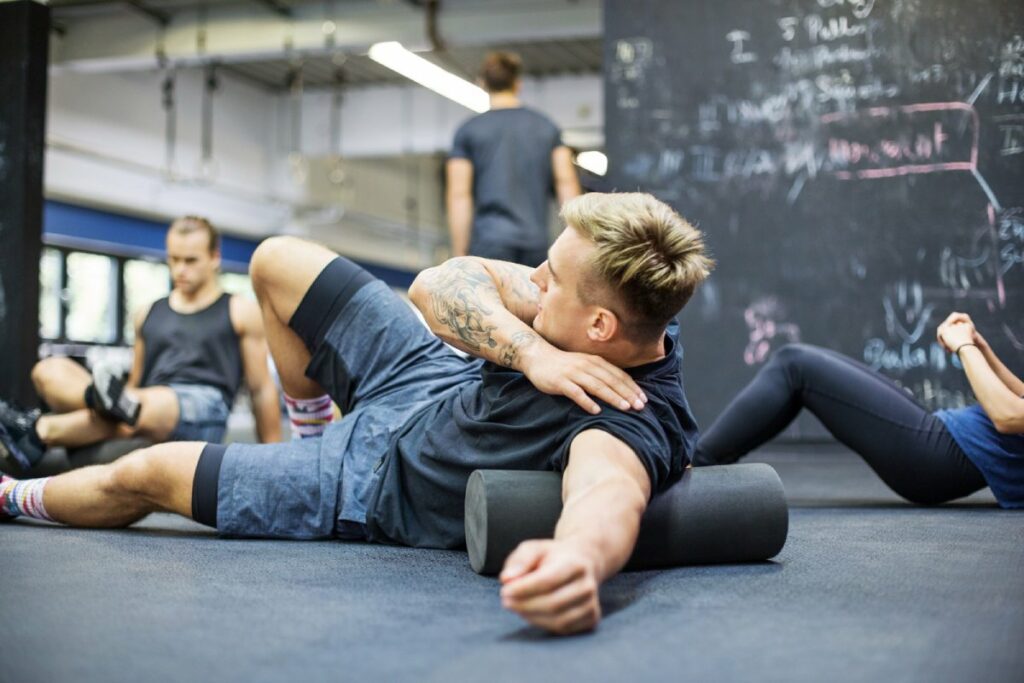
Understanding Foam Rolling
Foam rolling, a self-massage technique, is designed to release muscle tightness and trigger points (knots). It involves using your body weight to apply pressure to specific muscle areas with a foam roller, a cylindrical tool made of compressed foam.
Benefits of Foam Rolling
Research indicates that foam rolling can significantly improve range of motion, flexibility, and reduce muscle soreness after workouts. It helps in breaking down soft tissue adhesions and scar tissue. By increasing blood flow and elasticity of muscle tissue, joints, and fascia, foam rolling aids in a quicker recovery and return to high performance (Source).
Optimal Technique
For best results, foam rolling should be done with slow, controlled movements. Focus on tender areas, but avoid rolling directly over joints or bones. Spend about 90 to 120 seconds on each muscle group, adjusting pressure as needed. It’s most effective when used post-exercise to aid in recovery and reduce delayed onset muscle soreness (DOMS).
Incorporating into Routine
Incorporate foam rolling into your regular workout routine, especially after exercises that heavily engage the targeted muscles. It’s also beneficial as a part of a dynamic warm-up to increase blood flow and flexibility.
Precautions
While foam rolling is generally safe, it’s crucial to listen to your body and avoid over-rolling, which can lead to increased inflammation and discomfort. If you have any specific medical conditions or injuries, consult with a healthcare professional before starting a foam rolling routine.
Here’s a great, affordable option on Amazon
Compression Garments: Circulation Boosters

Compression garments (CGs) are tight-fitting apparel designed to exert mechanical pressure on the body. Commonly used in both sports and clinical settings, they aim to improve blood flow and provide muscular support.
How Do They Work?
The primary function of CGs is to enhance venous return, the process of blood flowing back to the heart. This is achieved by applying graduated pressure on the limbs, which potentially helps in reducing muscle oscillation during movement, decreasing the risk of muscle damage.
Benefits in Sports Recovery
CGs are reported to aid in recovery, especially after resistance exercises. They have been found to effectively reduce perceived muscle soreness and may assist in improving next-day endurance performance. The use of CGs has also been associated with reduced lactate dehydrogenase levels, indicating a positive impact on muscle recovery (Source).
Optimal Use
For maximum efficacy, CGs should be worn during and after exercise. The duration of wear can vary depending on the individual’s needs and the type of exercise performed. Consistent use, particularly post-exercise, is suggested to reap the full benefits.
Considerations and Precautions
While CGs are generally safe, they should be properly fitted to ensure effective compression without restricting blood flow. Athletes with specific medical conditions should consult a healthcare professional before using compression garments.
I use these compression socks whenever I run
Electrical Muscle Stimulation (EMS): Neuromuscular Dynamo
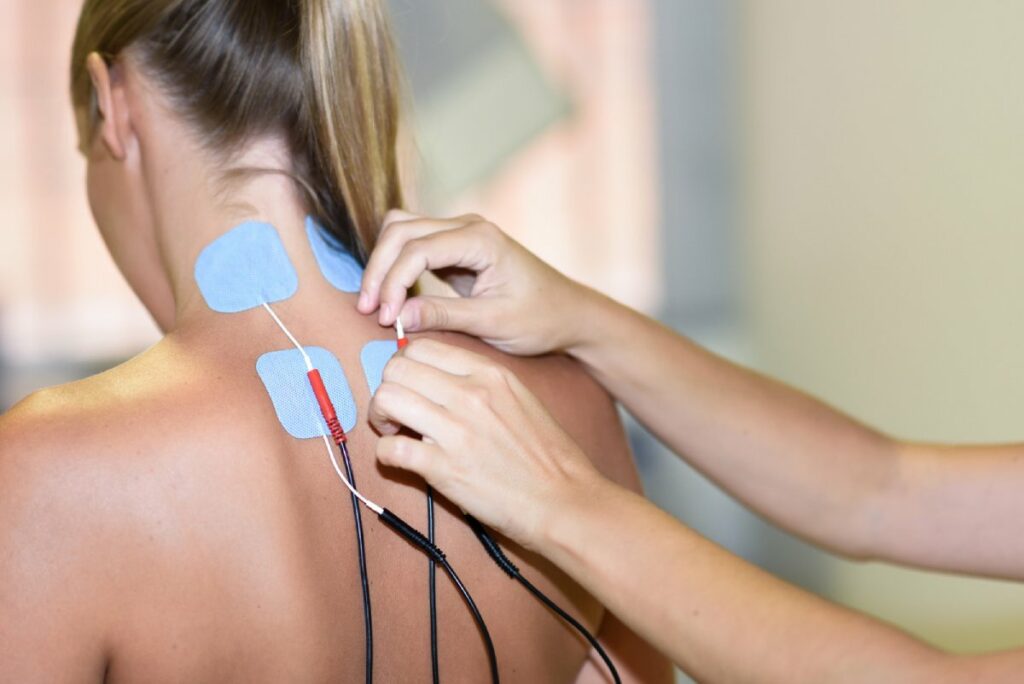
Electrical Muscle Stimulation (EMS), also known as electromyostimulation, uses surface electrodes to induce muscle contractions. This aims to increase muscle blood flow and promote the removal of muscle metabolites.
How Does EMS Work?
EMS aims to facilitate recovery by stimulating muscle contractions, which are believed to enhance blood flow and metabolic waste removal. The effectiveness of this method for recovery from exercise, however, has shown inconsistent results.
Benefits and Efficiency in Sports Recovery
While some studies indicate a potential benefit of EMS in reducing perceived muscle pain or exertion, the overall evidence for its efficacy in enhancing recovery or improving performance is not strongly supported. The variation in devices, protocols, electrode placement, and stimulation intensities contributes to these mixed results (Source).
Optimal Use and Considerations
Considering the inconsistent findings and the potential for discomfort, EMS should be used judiciously. Factors like stimulation intensity, electrode placement, and individual tolerance should be carefully considered. EMS is most beneficial when tailored to the specific needs of the athlete.
I use this TENS unit when I have a nagging, low-back pain
Cryotherapy Chambers: The Chilly Rejuvenator
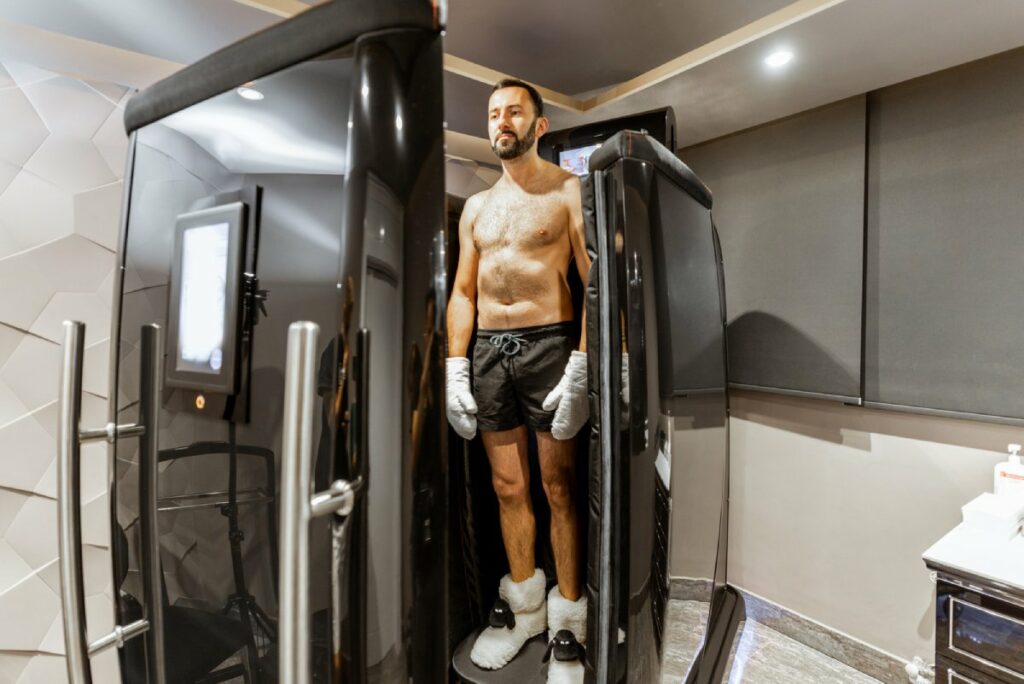
Cryotherapy Chambers involve exposure to very cold air (around −100°C or −150°F) for short durations. They are designed to stimulate the body’s natural recovery processes.
How Do Cryotherapy Chambers Work?
The primary mechanism of Cryotherapy Chambers is to reduce inflammation and lower markers of muscle damage. This extreme cold exposure helps in reducing muscle pain and potentially speeds up recovery after intense physical activity.
Benefits and Efficiency in Sports Recovery
Studies have shown that Cryotherapy Chambers can reduce muscle pain, lower inflammation, and improve subjective recovery feelings. They also show potential in improving recovery of athletic performance, particularly in reducing muscle soreness following exercise (Source).
Optimal Use and Considerations
For effective use, athletes typically undergo sessions lasting 2 to 4 minutes. While beneficial, it’s essential to note that similar benefits can be achieved through cold water immersion, which is a more accessible and cost-effective method. Cryotherapy should be used judiciously, considering personal tolerance and specific recovery needs.
Hydrotherapy (Cold Plunge): Healing Power of Water
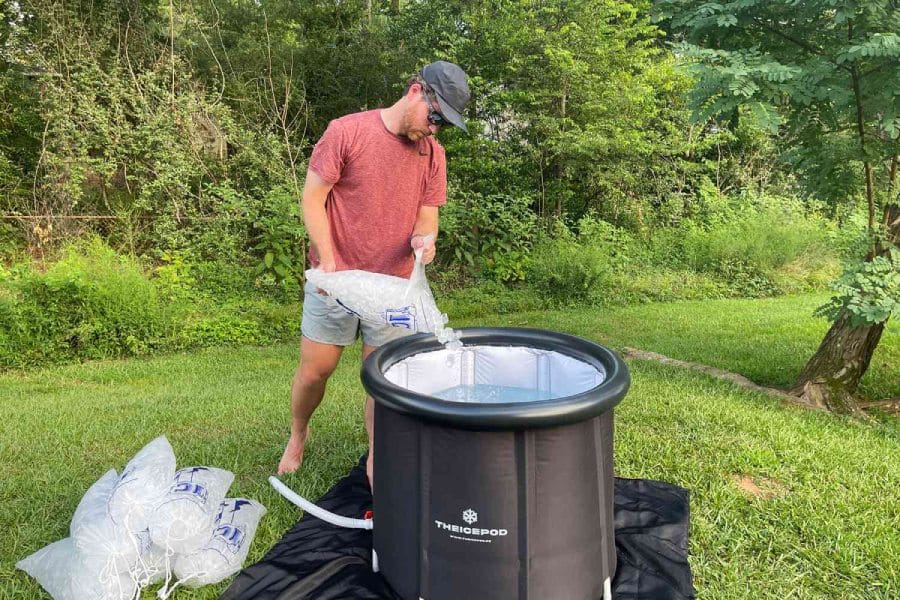
Hydrotherapy encompasses recovery strategies involving water immersion, notably Cold Water Immersion (CWI) and Contrast Water Therapy (CWT). CWI involves immersing the body in cold water, while CWT alternates between hot and cold water immersion.
Mechanism of Action
The primary aim of hydrotherapy is to reduce muscle soreness and inflammation post-exercise. Cold water can cause vasoconstriction, reducing blood flow and swelling, while the alternating temperatures in CWT may enhance blood circulation and metabolic waste removal.
Benefits and Optimal Use
Hydrotherapy, particularly CWI, is recommended at temperatures of 11–15°C (52–59°F) for about 11–15 minutes. CWT usually involves equal time in hot (38–40°C) and cold water. These methods are reported to be effective in reducing muscle soreness, and some studies suggest benefits for recovery in athletic performance (Source).
Considerations
While hydrotherapy is generally beneficial, its chronic use, especially following resistance training, may impact the natural muscle adaptation and recovery processes. Athletes are advised to use hydrotherapy strategically, considering their training schedule and recovery needs.
I don’t own one, but I’ve heard great things about this affordable cold plunge
Photobiomodulation (Red Light): Light Therapy for Recovery
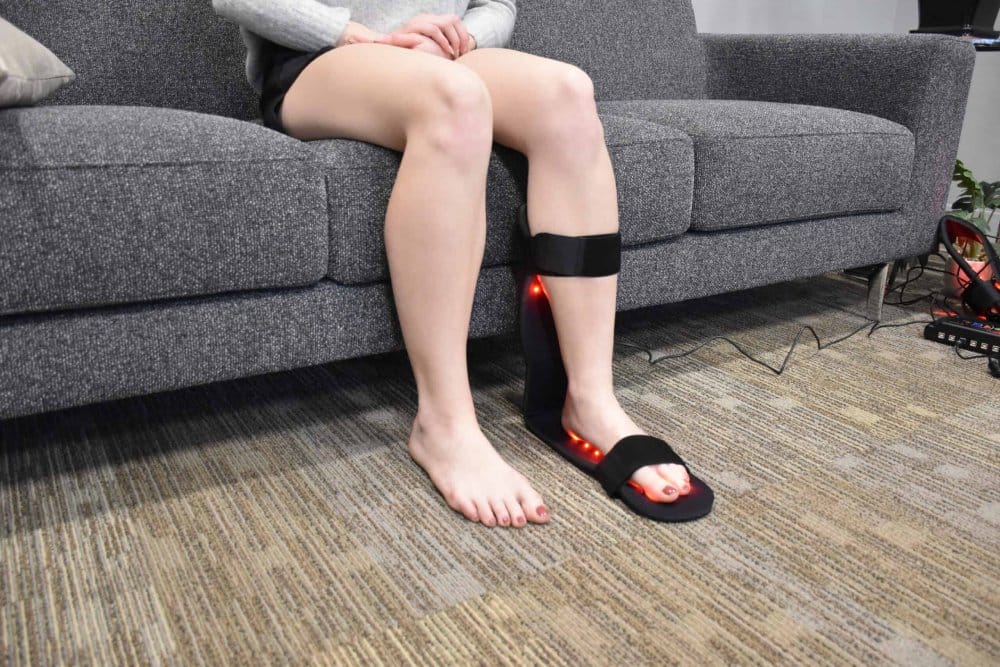
Photobiomodulation (PBM) is a form of light therapy using lasers or light-emitting diodes (LEDs). It aims to enhance cellular function and promote recovery and healing.
How Does PBM Work?
PBM works at the cellular level, mainly targeting the mitochondria. It’s believed to enhance adenosine triphosphate (ATP) production, leading to increased energy availability in cells. This process helps in muscle recovery and reduces inflammation and pain.
Benefits and Optimal Use in Sports Recovery
PBM has shown promising results in reducing muscle fatigue, enhancing muscle strength and endurance performance. Optimal use involves specific wavelengths and dosages, which vary based on the device and treatment area. It’s crucial to follow manufacturer guidelines for effective results (Source).
Considerations
While PBM shows potential benefits, more research is needed to standardize protocols and understand long-term effects. Athletes should use PBM as a supplement to other recovery methods and not as a sole treatment.
This is quickly becoming my go-to after workouts with a lot of box jumps, double-unders, etc
Active Recovery: Gentle Movement Magic

Active recovery involves engaging in low to moderate intensity exercises considerably below the lactate threshold. This method is popular among endurance and team sport athletes.
Mechanism and Benefits
Active recovery is thought to aid muscular recovery by enhancing blood lactate clearance and reducing muscle soreness and tenderness. This contrasts with passive recovery methods.
Optimal Use
The intensity of active recovery should be sufficient to raise heart rate and blood flow to facilitate metabolic by-product removal, without causing additional muscle damage or fatigue. Activities like yoga, cycling, and light jogging are commonly used.
Research Insights
Active recovery shows benefits in reducing soreness perception post-exercise, though its effects on performance and functional capacity are mixed. It increases total energy expenditure and should be factored into overall training and nutrition plans (Source).
Stretching: Flexibility’s Role in Recovery
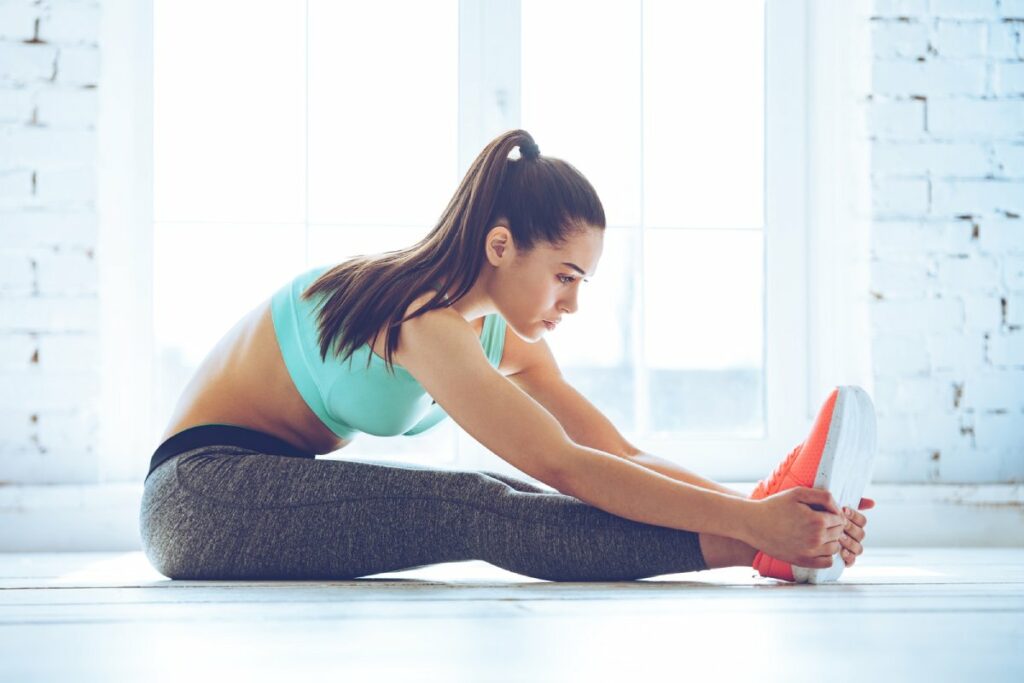
Stretching involves elongating the muscles and connective tissues to improve flexibility and range of motion. It’s a common component of athletic cool-downs and can include various forms, such as dynamic, static, or proprioceptive neuromuscular facilitation (PNF) stretching.
How Does Stretching Work?
Stretching works by increasing muscle and tendon length, which can reduce stiffness and potentially aid in recovery. It’s thought to help in the alignment of collagen fibers and improve blood flow, aiding in the repair and recovery of muscle tissues.
Benefits and Optimal Use in Sports Recovery
The study suggests that while stretching does not significantly reduce delayed-onset muscle soreness (DOMS) or improve strength recovery compared to other methods, it can be beneficial for improving range of motion. It’s most effective when performed after exercise and can be incorporated into daily routines to maintain flexibility (Source).
Considerations
Stretching should be done carefully to avoid overextension and potential injury. It’s important to focus on major muscle groups and hold each stretch for a sufficient duration, typically around 30 seconds to a minute, without bouncing.
Recovery Strategies with Lower Evidence
Sauna Use: Relaxation with Limited Recovery Benefits
Let’s start with the Sauna. It’s a place of serenity, where heat soothes sore muscles and induces relaxation. While many athletes enjoy the sauna for its calming effects and believe in its ability to enhance recovery, scientific evidence supporting these claims is limited. The heat can promote circulation, sure, but its direct impact on muscle recovery and performance enhancement is less clear.
Recovery Boots and Sleeves: Comfort Over Conviction
Moving on to Recovery Boots and Sleeves. They’re designed to provide compression, theoretically aiding in circulation and recovery. While users often report feelings of relief and reduced soreness, scientific backing is not as robust. These devices are more about comfort and less about proven recovery enhancement.
Occlusion Cuffs: A Niche Approach with Questionable Impact
Occlusion Cuffs represent a more niche recovery strategy. They restrict blood flow to the limbs, supposedly to enhance muscle growth and recovery. However, their effectiveness and safety for widespread use remain contentious. They might have a place in specific training regimes, but for the general athletic population, their benefits are still up for debate.
Float Tanks: Relaxation, Not Recovery
Float Tanks offer a unique experience of sensory deprivation and relaxation. Floating in a tank filled with saltwater can be a tranquil experience, but when it comes to actual recovery from physical exertion, the evidence is thin. They might aid in mental relaxation, but their physical recovery benefits are yet to be firmly established.
Massage Guns: Temporary Relief, Lacking Long-Term Benefits
Finally, let’s talk about Massage Guns. These popular devices offer a convenient way to self-administer deep-tissue massage. While they provide temporary relief from muscle soreness and stiffness, studies are yet to conclusively prove their effectiveness in enhancing muscle recovery or performance in the long run.
Mental Resilience: A Cornerstone of Recovery
Mental resilience isn’t just a buzzword; it’s the bedrock of effective recovery. Athletes with a positive mindset and strong mental fortitude often experience quicker and more comprehensive recovery. Why? Because mental stress can directly impact physical recovery. A positive attitude and mental resilience can lead to better sleep quality, less perceived exertion during training, and a more effective approach to recovery strategies.
The Impact of Stress and Anxiety
Let’s talk about stress and anxiety – they’re not just mental states; they have tangible physical repercussions. Chronic stress and anxiety can lead to prolonged muscle tension, disrupt sleep patterns, and even affect metabolic processes, all of which can hamper recovery. Athletes who manage stress and maintain a calm demeanor tend to recover more efficiently.
Social Support: The Invisible Recovery Aid
Never underestimate the power of social support. It comes in many forms – from coaches and teammates to family and friends. This support network can significantly influence an athlete’s recovery process. Positive social interactions can reduce stress levels, provide emotional support, and even offer practical help in managing recovery protocols. A strong support system is like a safety net, providing emotional and practical assistance when needed.
The Role of Psychological Recovery Techniques
Techniques such as mindfulness, meditation, and visualization are gaining traction in the athletic world for good reason. They help athletes to mentally decompress, focus, and maintain motivation, all of which are crucial for effective recovery. Integrating these techniques into recovery routines can lead to better mental balance and, consequently, a more efficient physical recovery process.
Placebo and Belief in Recovery
The Power of Belief in Healing
The placebo effect – it’s not just a term for clinical trials. In the realm of athletic recovery, the belief an athlete holds about a particular recovery method can significantly impact its effectiveness. It’s a fascinating intersection where psychology meets physiology. When athletes believe in the efficacy of their recovery strategy, whether it’s a foam roller, a nutrition plan, or a recovery device, this belief can positively influence their physical recovery process.
Understanding the Mind-Body Connection
This phenomenon isn’t about tricking the mind; it’s about understanding the profound connection between mental and physical health. Positive beliefs and expectations can lead to better engagement with the recovery process, more consistent application of recovery strategies, and a more optimistic outlook on healing and performance.
Real Benefits or Psychological Comfort?
The intriguing question is, are the benefits purely psychological or do they translate into actual physiological improvements? Research suggests it’s a bit of both. While the placebo effect can enhance an athlete’s perception of recovery, it can also lead to tangible improvements in pain reduction, muscle recovery, and performance outcomes.
Individual Differences in Response to Recovery Methods
It’s crucial to note that athletes’ responses to recovery strategies are highly individual. What works like a charm for one may not have the same impact on another. This individual variance is partly due to differences in belief and expectations about the effectiveness of the recovery method.
Crafting a Recovery Plan That Resonates
Given the importance of belief in the recovery process, it becomes essential for athletes to choose recovery strategies that they genuinely believe in. This doesn’t mean blindly following trends, but rather selecting methods that resonate on a personal level, backed by a combination of scientific evidence and personal conviction.
Long-term Implications of Recovery Strategies
Building a Sustainable Recovery Regimen
When it comes to recovery, it’s not just about the immediate aftermath of a workout. We need to think long-term. Chronic use of certain recovery strategies can have a profound impact on an athlete’s health and performance. It’s about creating a sustainable recovery regimen that supports an athlete’s career over years, not just days.
Risks of Over-Reliance on Certain Methods
Let’s face it: there’s a risk of over-reliance on certain recovery devices or methods. For example, consistent use of recovery boots or excessive foam rolling can lead to a dependency where the body might begin to rely on these aids for recovery, potentially reducing its natural ability to heal and adapt. Balance is key.
Adaptation: The Body’s Remarkable Ability
The human body is remarkable in its ability to adapt. This is why periodization in recovery, much like in training, is crucial. Just as muscles grow accustomed to a specific workout routine, they can also adapt to a recovery routine. Mixing up recovery methods – combining active recovery, stretching, massage, and other techniques – ensures the body continues to respond optimally.
Psychological Effects of Recovery Routines
We can’t overlook the psychological aspect. A monotonous recovery routine can lead to mental fatigue and a lack of motivation. Varying recovery strategies can keep things fresh, not only for the body but also for the mind, contributing to overall well-being and performance.
Long-term Health and Performance Outcomes
Finally, the ultimate goal of any recovery strategy is to enhance long-term health and performance. This means evaluating the efficacy of each method not just in the short term but over an extended period. Recovery strategies should evolve as the athlete evolves, adapting to changing needs, goals, and responses of the body.
References
- https://www.mdpi.com/2075-4663/11/11/213
- https://pubmed.ncbi.nlm.nih.gov/32507141/
- https://www.mdpi.com/2673-7248/2/3/22
- https://journals.lww.com/nsca-jscr/fulltext/2014/09000/neuromuscular_electrical_stimulation_during.12.aspx
- https://www.thieme-connect.de/products/ejournals/abstract/10.1055/s-0043-114861
- https://journals.lww.com/nsca-jscr/fulltext/2017/05000/effects_of_cold_water_immersion_and_contrast_water.32.aspx
- https://link.springer.com/article/10.1007/s10103-017-2368-6
- https://pubmed.ncbi.nlm.nih.gov/18202563/
- https://cdnsciencepub.com/doi/10.1139/apnm-2015-0235














